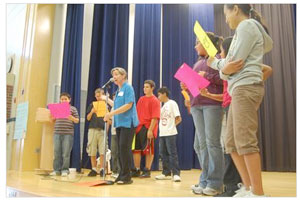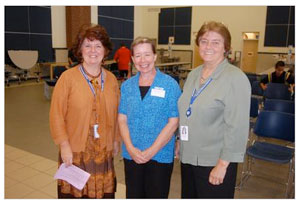 |
||||
Argenziano School students from grades 6, 7 and 8 are shown with storyteller Elisa Pearmain during a demonstration of the roles played by onlookers in a typical bullying incident. During assemblies for grades 3 to 8 on Sept. 15, Pearmain focused on small but important actions children can take to help keep their communities respectful and safe for everyone. Building a respectful community where individuals are truly safe is an age-old challenge. Through folktales, special guest Elisa Pearmain helped students at the Argenziano School focus on this challenge. Using her versatile voice and a full spectrum of dance-like movements, she shared stories from five continents. In two presentations Sept. 15, Pearmain portrayed characters that ranged from butterflies and flowers to a river goddess, a fourth-grader, and a king. And students listened in spellbound silence, utterly enchanted. One of Pearmain’s goals is to add to her listeners’ understanding of what bullying is. And she wants to increase their repertoire of ways to prevent it. Although the tales she told at the Argenziano were as old as the hills, each one held wisdom for 21st Century life. In “Feathers,” for example, she evoked a Polish village and its most trusted resident, a rabbi. A certain villager had been telling hurtful stories about his neighbors. When the rabbi called him in for a chat, the cheerful blabbermouth said, “It’s just words. Not a big deal.” It would be easy to take his words back, he figured; no harm done. But the rabbi knew better. Vividly showing what happens to little bits of gossip, the learned man emptied a pillow full of feathers into the breeze. “I want you to get all of those feathers and put them back in the pillow case,” he said. Pearmain also shared a Zulu tale in which a group of teens tease, trick and exclude a peer. At the story’s close, she invited volunteers up to the stage to demonstrate the roles people tend to play in a bullying incident. Along with the bully and his or her target, there may be “join-ins” who cheer the bully on, passive supporters who laugh or smile, and onlookers who are thinking, “It’s not my problem,” or “I don’t know how to help,” or “I’m afraid I might be bullied too.” Sometimes there are also people willing to say, “stop!” or to go get assistance. These “helpers” possess both the understanding and the courage to take action. And their actions, large or small, make all the difference to the safety of a community. Pearmain’s book, “Once Upon a Time: Storytelling to Teach Character and Prevent Bullying,” includes 99 folktales collected and adapted for use by classroom teachers. During an afternoon workshop, she shared some of her storytelling techniques with the Argenziano faculty. For one thing, and it’s an important thing, she only performs stories that she really loves. And, because she wants to be ready for many different audiences and circumstances, she does not use memorization. Instead, she looks at what a story’s “bullet points” are and makes sure she knows those points inside out. Then she closes her eyes, taking time to visualize the place where the story happens and trying her best to walk around that place in the shoes of its characters. Finally, just before performing a tale, she takes a deep breath and spends some silent time being sure to “reconnect to the crowning moment of the story.”
Pearmain encouraged the teachers to try some classroom activities that can add to a child’s listening experience. She noted that even children who have struggled to gain reading skills can “shine at storytelling.” When students who listen to a story are able to visualize its setting and then retell it or act it out themselves, they “make that story their own.” With any beloved tale, “if kids can fairly early retell it, it gets under their skin and they can get more out of it.” Counselor-educator Sharon Staples, who coordinated Elisa Pearmain’s visits with parents, students and teachers Sept. 10, 15 and 16, spoke gratefully of the extra dimension these presentations have given to the violence prevention curriculum used at the Argenziano. Introduced five years ago at the school, the Second Step curriculum was recently adopted in elementary schools citywide. Pearmain’s presentations were made possible through a grant from the Somerville Arts Council, and copies of her storytelling resource book were donated to the school library by the Argenziano PTA.
|

